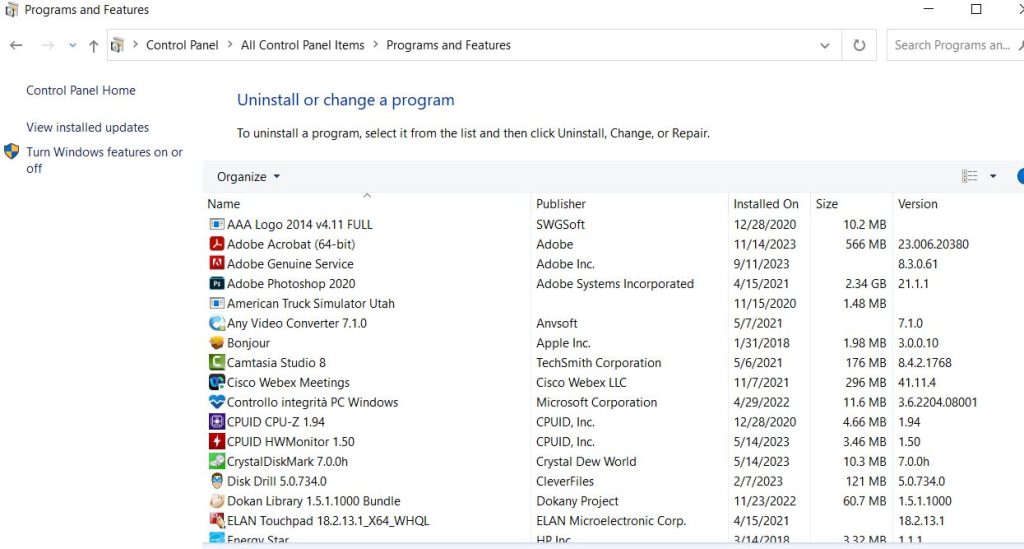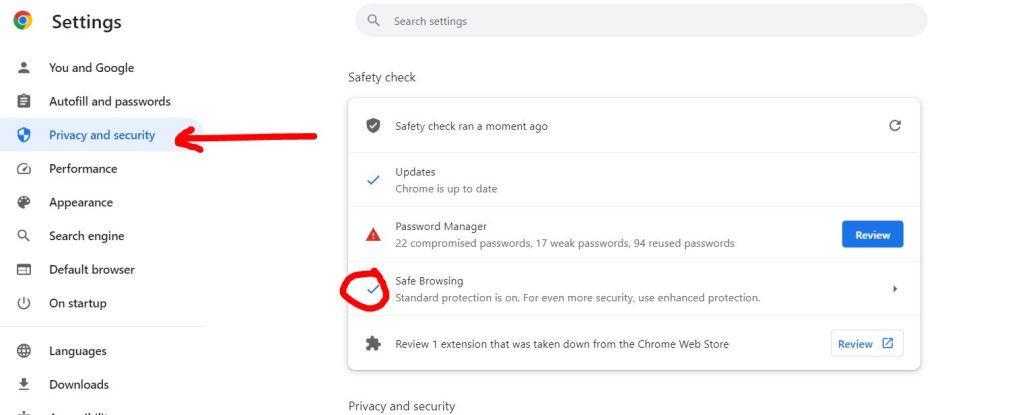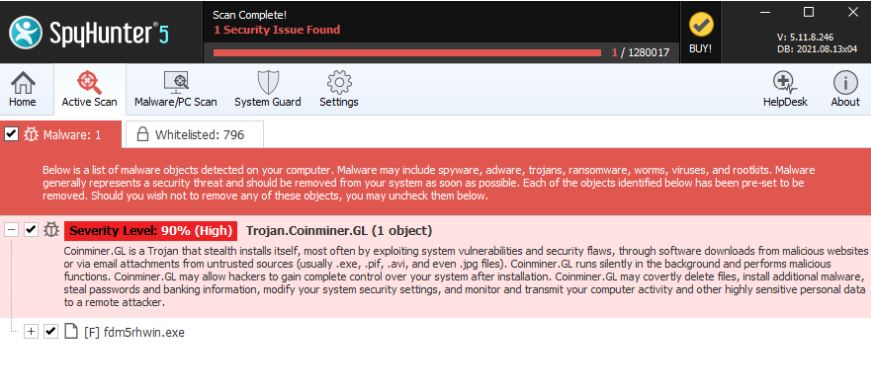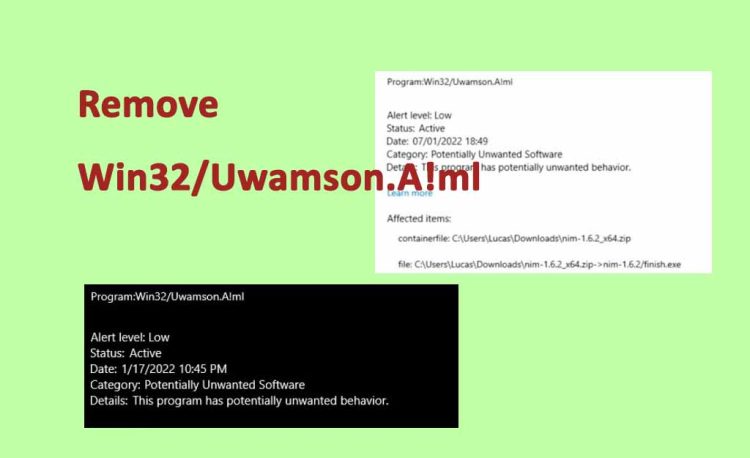Win32/Uwamson.A!ml is a harmful computer trojan that can destroy sensitive data or send private data to hackers.
This malware is designed to make money through any illegal means possible. The malware typically infiltrates devices where applications are downloaded from untrustworthy sources and unapproved emails.
Win32/Uwamson.A!ml remains undetected for a long time and is only discovered after significant damage has been done.
On the infected machine, the virus records personal data such as passwords, credit card numbers, IP addresses, and keystrokes for the attackers to receive money.

How Win32/Uwamson.A!ml Virus Affects Your PC
The Win32/Uwamson.A!ml virus can infiltrate your system via a variety of means. Hackers employ a variety of techniques to connect with new victims.
This malware can be delivered to your computer as an attachment to spam emails sent by hackers using fictitious names.
These emails may appear to be legitimate, such as credit card bills, phone bills, and bank statements.
The majority of users fall for this and do not verify the sender’s email address or other information.
Opening such emails, downloading attachments, and opening them without scanning can all lead to the infection of your computer.
This harmful malware is also being distributed in conjunction with free third-party programs, shareware, cracked software, illegal patches, and bogus updates.
Aside from that, the Win32/Uwamson.A!ml virus can infect your computer when you visit malicious websites.
How to Remove Win32/Uwamson.A!ml
Regardless of your level of experience, manually identifying the Win32/Uwamson.A!ml virus can be a challenging task due to its tendency to change both its location and file name.
Additionally, it is capable of dispersing copies under various names and locations.
In addition, this infamous threat can regenerate registry files on your computer in the unlikely event that it is erased.
You must delete all of the related files to eliminate this Win32/Uwamson.A!ml virus.
It jeopardizes not just the security of your system but also your privacy.
Therefore, it is preferable if you get rid of this infection from your system as soon as you become aware of it.
We have produced an extremely thorough and instructional step-by-step guide to assist you in safely and fully removing the Win32/Uwamson.A!ml virus from your computer.
1. Start PC in Safe Mode with Networking
Follow the steps below:
- On the keyboard, press the Windows Key + R keys together.
- In the Run Box, type msconfig and press the OK button.
- Click the Boot tab to bring up the System Configuration dialogue.
- Select Safe Boot, check the network box, click Apply, and then OK.

2. Uninstall Win32/Uwamson.A!ml from Windows PC
- First, press the Windows Key + R buttons at the same time.
- In the Run box, type appwiz.cpl and then press the OK button.
- The Windows Programs and Features will now appear on the screen.
- Locate and eliminate any Win32/Uwamson.A!ml-related or malicious programs.

3. End Malicious Processes from Task Manager
• On the keyboard, press the Windows Key + R buttons together.
• In the Run Box, type taskmgr and then press the OK button.
• Locate any Win32/Uwamson.A!ml-related or malicious processes.
• Right-click on it now and choose End process.

4. Remove Virus Related Windows Registry Entries
- On the keyboard, press the Windows Key + R buttons together.
- In the Run Box, type regedit and then press the OK button.
- Open Registry Editor, and then press CTRL + F together.
- Now, type Win32/Uwamson.A!ml and press the Find Next button.
- Find and delete all related entries one by one.
Please note: If you don’t have advanced knowledge of registry files, tampering with them may not be a good idea.
Deleting the incorrect file can cause your entire system to fail. Proceed at your own risk, or skip this step entirely.
You can avoid all problems by using the Automatic Removal method.
5. Remove Win32/Uwamson.A!ml from Browsers
Threats like this typically alter the browser in several ways that enable them to monitor their victims’ online activity.
The virus must be eliminated from the browser to prevent a recurrence. To get rid of this infection from your browser, follow the instructions below.
Delete Malicious Extensions from Browser:
Nowadays, a lot of spyware can take over a victim’s browser and display ads, offers, alerts, notifications, or even steal their data.
To get rid of potentially harmful extensions from your browser, follow the instructions below.
Remove from Google Chrome:
- Run Google Chrome and select the three dots menu
- Select More tools, then Extensions to see all installed Extensions on Chrome.
- Select the virus-related extensions and then click the trash can icon to remove them entirely.
Remove from Mozilla Firefox:
- Launch Mozilla Firefox and select Menu from the upper right corner.
- Select the Add-ons option from the list’s drop-down menu.
- Select Extensions to view all installed extensions on your browser.
- Select the virus-related extensions and then click the Remove button.
Remove from Microsoft Edge:
- Open the Microsoft Edge browser and select More Tools from the upper right corner.
- To see extensions on your browser, select the Extensions option from the drop-down menu.
- To remove a virus-related extension, select it and then click the Uninstall button.
Remove from Internet Explorer:
- Open Internet Explorer and then select the Menu option in the upper right corner.
- To view the installed extension, select the Manage Add-ons option from the drop-down list.
- Locate all virus-related or malicious extensions and disable them by clicking the Disable button.
6. Reset Your Browsers to Default
After removing Win32/Uwamson.A!ml from your browser, you should reset it to its default settings to undo any changes made by the virus.
To do so, follow the steps below:
Google Chrome Reset:
- When Google Chrome is open, click Menu and choose Settings.
- Navigate to the bottom of the screen and select the Show Advanced Settings option.
- To restore the settings to their initial defaults, select Restore from the Reset and Clean Up menu.
- To reset your Chrome browser, click the Reset Settings button at last.
Mozilla Firefox Reset:
- Launch the Mozilla Firefox web browser and open the main menu.
- From the menu drop-down, select Troubleshooting Information.
- Next, select Refresh Firefox and provide confirmation.
Microsoft Edge Reset:
- Launch the Microsoft Edge browser, and select Settings from the More Tools menu.
- Select the first three options by clicking on the “Choose what to clear” option, and then press the “Clear” button.
Safari Reset:
- To reset your Safari browser, open it, tap the Safari menu, and choose Reset Safari.
- After checking every box, click the Reset button to complete the process.
Internet Explorer Reset:
- Click the Menu icon and select Internet options after opening Internet Explorer.
- Click the Reset button after selecting the Advanced tab.
- Press the Reset button after selecting the Delete personal settings option.
You can prevent threats like Win32/Uwamson.A!ml by following the steps below to enable your web browser’s built-in dangerous site protection.
If you wish to disable your browser’s malware protection, simply follow these steps.
Google Chrome:
- Go to Chrome: //settings in the URL bar of your open Chrome browser and hit Enter.
- Navigate to the bottom of the page and choose “Show advanced settings.”
- Locate the Privacy and Security section and select Google Services and Sync from there.
- Now enable the Safe Browsing feature.

Safari Browser:
- Start the Safari browser, then tap the menu bar and choose Preferences.
- You now need to open your Safari browser’s Security settings.
- Select the box labeled “Warn When Visiting a Fraudulent Website” located in the Fraudulent Sites area.
Mozilla Firefox:
- Open the Firefox browser, click Menu, then choose Options from the drop-down menu.
- Now choose the Security option and pick the items listed below
- Warn me when sites try to install add-ons
- Block-reported attack sites
- Block-reported web forgeries
Automatic Removal of Win32/Uwamson.A!ml Virus
As you are already aware, Win32/Uwamson.A!ml is a well-known and crafty piece of malware that is quite simple for any user to manually remove.
Through files, shortcuts, or settings that it has already established on your computer, this virus can re-enter the infected machine.
The only way to eradicate this infection and prevent it from ever entering your system again is to remove all of those at once.
Thus, to effectively remove Win32/Uwamson.A!ml and save time and effort, use a strong Automatic Removal Tool.
This software is an extremely potent and reliable anti-malware tool that can identify any hidden danger, including Trojan horses, ransomware, worms, spyware, rootkits, and many more.
Use SpyHunter 5 to Remove Win32/Uwamson.A!ml

- Download the SpyHunter 5.
- To install the software, double-click the installer that you downloaded.
- Click the “Start Scan Now” button after launching the anti-malware program.
- The program will check your computer for viruses and other hidden dangers.
- To view the results and remove Win32/Uwamson.A!ml and other threats, click the Next button.
Conclusion
The first line of defence most users consider when it comes to computer security is installing an anti-virus or anti-malware program.
This is an intelligent move that is most likely the most workable way to defend your computer from a Win32/Uwasson.A!ml attack.
It’s crucial to keep in mind nevertheless that security software does not provide absolute protection. Being cautious when using still constitutes the majority of prevention.
As a result, the following details serve as recommendations to assist you in safeguarding your computer against virus infections.

It’s me Mosaab, the founder and leading author of MalwareYeti.com. Over the years, I have gained a lot of experience when it comes down to building or fixing computers. Throughout my journey, I’ve built gaming PCs, fixed irritating Windows errors, and removed sticky malware/viruses that have affected machines. You can learn more about me on our About us page.

